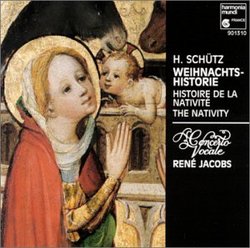| All Artists: Heinrich Schutz, René Jacobs, Ensemble Instrumental, Concerto Vocale, Gottfried Bach, Hanne Mari Orbaek, Susanne Ryden, Maria Cristina Kiehr, Matthias Widmaier, Gerd Turk, Martin Hummel, Andreas Lebeda, Ulrich Messthaler, Andreas Scholl, Franz-Josef Selig, Akira Tachikawa, Lena Susanne Norin Title: Schütz: Weihnachtshistorie (The Nativity) Members Wishing: 1 Total Copies: 0 Label: Harmonia Mundi Fr. Release Date: 12/7/1992 Album Type: Import Genres: Special Interest, Pop, Classical Styles: Holiday & Wedding, Vocal Pop, Opera & Classical Vocal, Historical Periods, Baroque (c.1600-1750) Number of Discs: 1 SwapaCD Credits: 1 |
Search - Heinrich Schutz, René Jacobs, Ensemble Instrumental :: Schütz: Weihnachtshistorie (The Nativity)
 | Heinrich Schutz, René Jacobs, Ensemble Instrumental Schütz: Weihnachtshistorie (The Nativity) Genres: Special Interest, Pop, Classical
|
Larger Image |
CD Details |
CD ReviewsA clear and bright Christmas Jacques COULARDEAU | OLLIERGUES France | 02/05/2005 (5 out of 5 stars) "The music is delicate and extremely fine. The polyphony is used at once but in two different ways, with repetitions of some words from one voice to another and with the vocalizing of some vowels in some strategic words. The form this polyphony takes is most often that of a canon or a fugue. It announces further developments but remains very simple. The instruments, when they are not used as plain accompaniment, are also used as voices in a way and they enter the canon and fugue form along with the voices themselves. But once again it all remains simple and the performing is very clear, light and in a way un-amplified. And at the same time the composer does not hesitate to use some high dives or high jumps in the music or the singing, one high-pitched voice suddenly climbing high on the scale from a lower-pitched voice or note. But these vocalizations and effects are delicately and simply wrought out avoiding all excessive ornamentation, each case aiming at emphasizing one syllable or word and not at showing the virtuosity of the singer or musician. It gives a very pleasant musical evocation of the birth of Jesus that does not want to conjure any awe or excessive admiration in us : it is more a beautidul story than an impressive miracle. But these pieces of music are also tales and the main interest is the vision of Mary given in this recording. In the Christmas Story Mary is in a totally secondary position. She is the mother and that's all. After the birth, the danger coming from Herod is emphasized by the fact that the three Magi go to Jerusalem and Herod to announce the birth of a new King of the Jews. It is then Herod that entrust the Magi with finding the child. They will do so but will not return to Jerusalem. Another element gives Joseph a very important role in the story. He is the one who is in touch with God through an angel in his dreams. Thus he learns that he has to get away to Egypt and then later on to come back. Mary is thus erased from the picture. In the next piece (SWV 333) we have the Annunciation, a double annunciation since Mary gets the message of her future pregnancy and at the same time she learns that Elizabeth is also pregnant (the future John the Baptist) after an intervention of the Holy Ghost who is going to visit Mary later on. But no mention whatsoever of the redeeming mission Mary gets then to free humanity of Eve's sin. The next piece given by René Jacobs (SWV 322) goes even farther since it is the evocation of the visitation by the Holy Spirit. It is reduced to dew and a rain of justice that plants a seed in the earth where it can germinate and grow into the Saviour. Mary has completely disappeared and been replaced by earth. Then in piece SWV 323 Mary is reduced to « dein Gewahl » for Joseph, that is to say his spouse (normally and today it is a masculine noun, but here it is used as a neutral noun that can generically cover either wife or husband), and the Angel explains to Joseph that Mary is pregnant with a son that was brought to her by the Holy Spirit. Joseph is thus valorised by being the only character of importance in this story but also by being called the son of David. The recording ends with two small pieces that just sing the birth of Christ. This general picture in this recording of an erased Mary and a Joseph who is pushed forward seems to represent a Protestant approach of Christmas. We could compare with the vision of the Virgin in Hildegard von Bingen for instance which is completely different since Mary becomes the essential character of the story because she redeems humanity of their sinful fate.
Dr Jacques COULARDEAU " |

 Track Listings (24) - Disc #1
Track Listings (24) - Disc #1